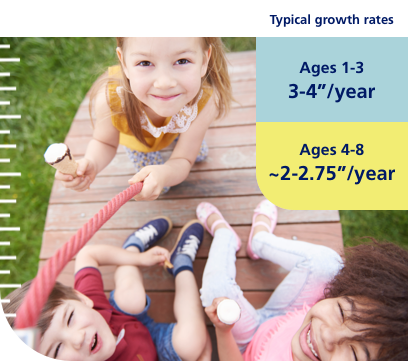When a child’s growth happens at a slower rate than their siblings or friends, parents may worry. That concern is understandable—after all, growth is an important indicator of a child’s health. Let’s explore this connection.

Connecting the dots between height and health.
When a child’s growth happens at a slower rate than their siblings or friends, parents may worry. That concern is understandable—after all, growth is an important indicator of a child’s health. Let’s explore this connection.
Connecting the dots between height and health.
When a child’s growth happens at a slower rate than their siblings or friends, parents may worry. That concern is understandable—after all, growth is an important indicator of a child’s health. Let’s explore this connection.
Growth is important. Here’s why.
From birth through adolescence, your child’s height and weight are tracked by their doctor. That’s because those points on the growth chart tell a story about health and development. When growth doesn’t progress normally, it could be a sign of an underlying medical condition.



Did you know?
Your child’s health care provider should check their height and weight at least once a year. The sooner your doctor knows if there’s a problem, the sooner they can take action.


Did you know?
Your child’s health care provider should check their height and weight at least once a year. The sooner your doctor knows if there’s a problem, the sooner they can take action.


The link between height and health.
For some children, the condition that’s causing slow growth may affect their overall health—and could have a lasting impact on their physical development. Depending on the underlying condition, here’s what may be at risk:
- Heart function
- Muscle development
- Bone health
- Body composition
- Learning development
- Heart function
- Muscle development
- Bone health
- Body composition
- Learning development
It’s perfectly normal to be concerned when there’s even a slight chance your child’s health could be at risk. Take action by being informed about growth disorders and then talking to your child’s doctor about their growth.
Worried about your child’s growth?
Your child’s doctor is the best resource for determining whether your child’s growth is a cause for concern. Consider having a conversation about growth if your child is:
Shorter than their friends and classmates
Growing more slowly than friends and classmates
Shorter than you were at that age
Reasons for delayed growth.
In some cases, a child simply grows more slowly than their friends and there is no cause for concern. Others are born small and don’t “catch up” in height as they get older. Certain diseases, medical conditions, and even rare genetic disorders may also slow or stop a child’s growth. In these instances, a child may require medication to help them grow.

Did you know?
Every child is unique and grows at his or her own rate. But in general, most children grow about about 3-4 inches per year from ages 1-3, and about 2–2.75 inches per year from ages 4–8.


Did you know?
Every child is unique and grows at his or her own rate. But in general, most children grow about about 3-4 inches per year from ages 1-3, and about 2–2.75 inches per year from ages 4–8.




Interested in learning more about growth? Sign up for updates.


Interested in learning more about growth? Sign up for updates.
Accurately measuring growth.
Are you familiar with the equipment and practices used for measuring your child?
Learn about growth disorders.
Do you know about the medical conditions that affect growth?


Why is it important to pay attention to my child’s growth?
Slow growth can suggest an underlying medical issue. Most often, there is no cause for concern, but your child’s doctor is the right person to speak to about any concerns you may have.
How will I know if my child is growing normally?
There is no one “normal” rate of growth for a child, but it’s important to trust your gut. If you notice your child isn’t outgrowing clothes or shoes, or if they’re the shortest in their class, there could be a problem. Take action by talking to your child’s doctor about their growth.


